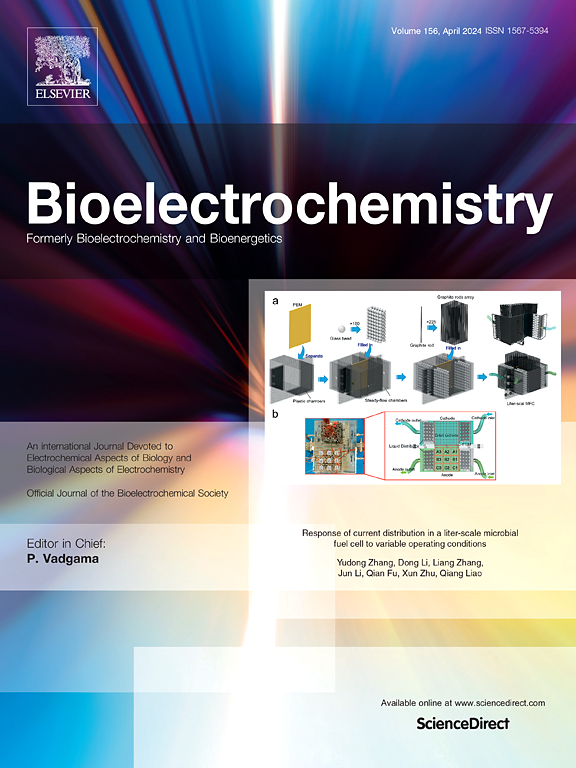脉冲包的MHz压缩有利于电穿孔的远程聚焦
IF 4.5
2区 化学
Q1 BIOCHEMISTRY & MOLECULAR BIOLOGY
引用次数: 0
摘要
脉冲电场(PEF)的刺激通常与PEF强度一致,并随着与电极的距离而减弱。由电场反转引起的双极对消可以抵消这种依赖性。远程聚焦可以通过纳秒脉冲包的刺激来实现,这些脉冲包在电极附近产生多相、双极干涉图案,同时在远程目标处保持单极PEF。研究了包重复率、脉冲宽度和包数对电穿孔远程聚焦及其在电极附近的抑制作用的影响。细胞单层被300、600或900ns脉冲包电穿孔,这些脉冲来自四个针状电极,它们以15.3毫米的对角线排列成正方形。电穿孔染料摄取在正方形中心达到峰值,沿洛伦兹分布向横向降低。更高的分组速率、更长的脉冲和更少的分组数量使中心峰锐化,将其半最大全宽度(FWHM)减小到1.1 mm,这是对角线的7.3%,仅为电极阵列面积的2.3%。在0.2 MHz时,电极附近的电穿孔比中心的弱40倍,尽管电场强度是中心的4倍。这种对脱靶效应的近乎完全抑制,加上更清晰的远程对焦,为生物医学应用中PEF效应的精确靶向提供了关键优势。本文章由计算机程序翻译,如有差异,请以英文原文为准。
MHz compression of pulse packets facilitates remote focusing of electroporation
Stimulation by pulsed electric fields (PEFs) normally follows PEF strength and weakens with distance from electrodes. Bipolar cancellation, caused by the electric field reversal, can offset this dependence. Remote focusing can be achieved by stimulation with nanosecond pulse packets that generate multiphasic, bipolar interference patterns near electrodes while preserving unipolar PEF at the remote target. We studied how the packet repetition rate, pulse width, and packet number influence remote focusing of electroporation and its suppression near electrodes. Cell monolayers were electroporated by packets of 300-, 600-, or 900-ns pulses from four needle electrodes arranged in a square with 15.3-mm diagonals. Electroporative dye uptake peaked at the center of the square and decreased laterally following Lorentzian distribution. Higher packet rates, longer pulses, and a smaller number of packets sharpened the central peak, reducing its full width at half maximum (FWHM) to 1.1 mm, which was 7.3 % of the diagonal and just 2.3 % of the electrode array area. At 0.2 MHz, electroporation near electrodes was 40-fold weaker than at the center, despite a 4-fold stronger electric field. This near-complete suppression of off-target effects, combined with sharper remote focusing, provides a critical advantage for precise targeting of PEF effects in biomedical applications.
求助全文
通过发布文献求助,成功后即可免费获取论文全文。
去求助
来源期刊

Bioelectrochemistry
生物-电化学
CiteScore
9.10
自引率
6.00%
发文量
238
审稿时长
38 days
期刊介绍:
An International Journal Devoted to Electrochemical Aspects of Biology and Biological Aspects of Electrochemistry
Bioelectrochemistry is an international journal devoted to electrochemical principles in biology and biological aspects of electrochemistry. It publishes experimental and theoretical papers dealing with the electrochemical aspects of:
• Electrified interfaces (electric double layers, adsorption, electron transfer, protein electrochemistry, basic principles of biosensors, biosensor interfaces and bio-nanosensor design and construction.
• Electric and magnetic field effects (field-dependent processes, field interactions with molecules, intramolecular field effects, sensory systems for electric and magnetic fields, molecular and cellular mechanisms)
• Bioenergetics and signal transduction (energy conversion, photosynthetic and visual membranes)
• Biomembranes and model membranes (thermodynamics and mechanics, membrane transport, electroporation, fusion and insertion)
• Electrochemical applications in medicine and biotechnology (drug delivery and gene transfer to cells and tissues, iontophoresis, skin electroporation, injury and repair).
• Organization and use of arrays in-vitro and in-vivo, including as part of feedback control.
• Electrochemical interrogation of biofilms as generated by microorganisms and tissue reaction associated with medical implants.
 求助内容:
求助内容: 应助结果提醒方式:
应助结果提醒方式:


